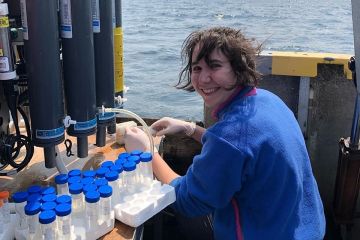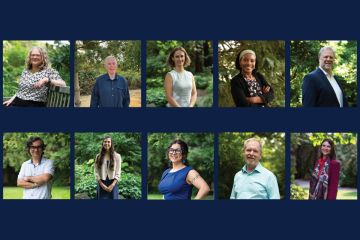Student chemistry symposium builds skills, confidence and elemental connections
- Julia Bobak
The exchange of ideas at major conferences is a chief driving force of scientific progress. Conferences and symposiums provide opportunities to share one's work with the global scientific community, to learn about and be inspired by emerging research and, perhaps most importantly, to network with other scientists.
On Jan. 30, the UVic Department of Chemistry hosted the Chemical Institute of Canada's 2014 Vancouver Island Section Student Symposium-a regional symposium offering a scaled-down conference experience to student researchers without the financial hurdles of registration fees and travel.
This year's event featured students from UVic, Vancouver Island University and Camosun. Each student presented a 15-minute talk on a chemistry topic of general interest, and fielded audience questions for another five minutes. UVic graduate student Brian Coleman, sporting pink and blue locks, kicked off the evening with a funny and informative talk titled "Exposing the Big Cover-Up: A Brief Introduction to the Science of Hair Dye." Camosun's Erin Bayus followed, inspiring the audience to consider the production of environmentally friendly biofuel. Larissa Richards of VIU gave an excellent and, in the context of this year's Nobel Peace Prize award, timely presentation on detoxification of chemical warfare agents. The final speaker, UVic undergraduate Mark Bracken, wowed symposium judges and audience alike in extolling the benefits of silicon chemistry.
In much the same way more advanced researchers are evaluated at national and international conferences, judging at this student symposium was based on scientific content, presentation quality, and replies to questions. UVic departments and local businesses provided cash prizes and sent representatives to hear the talks and participate in judging. In the end, the well-deserved top prize was awarded to VIU's Richards. The evening wrapped up like most other conferences, with mingling over refreshments serving as an informal networking opportunity between participants and local members of the chemistry community.
Despite a drop in participant numbers in 2014, this annual symposium continues to be an excellent on-campus opportunity for both graduate and undergraduate students. Brian Coleman, UVic's lone graduate representative this year, says that these smaller competitions allow him "to be a bit less formal and more candid, while still honing presentation skills." He also notes that by presenting on a topic of interest, rather than one's own research, student participants are given the opportunity to learn something new as well as to interact with a more general audience. Given the common challenge that scientists face-to communicate meaningful results to non-scientists-this is a skill that cannot be overvalued.
Although many undergraduate students rarely have an opportunity to attend major conferences, events like this can provide them with both the drive to pursue graduate studies or a research career as well as the r&e#180;sum&e#180; and contacts to do so. Second place winner Mark Bracken, who plans to pursue a master's degree after completing his BSc, says "by participating in an event like this we're put under a spotlight, like all chemists who submit journal articles or attend conferences. Without taking risks and accepting criticism, self-improvement is impossible. Meeting other chemists, putting this event on a CV, and learning about other chemistry topics is icing on the cake."
This symposium is not the only event UVic is hosting this year to encourage up-and-coming chemistry researchers. This May, students from across Western Canada will also arrive in Victoria for the 28th annual Western Canadian Undergraduate Chemistry Conference.
In this story
Keywords: chemistry
People: Brian Coleman, Erin Bayus, Mark Bracken




